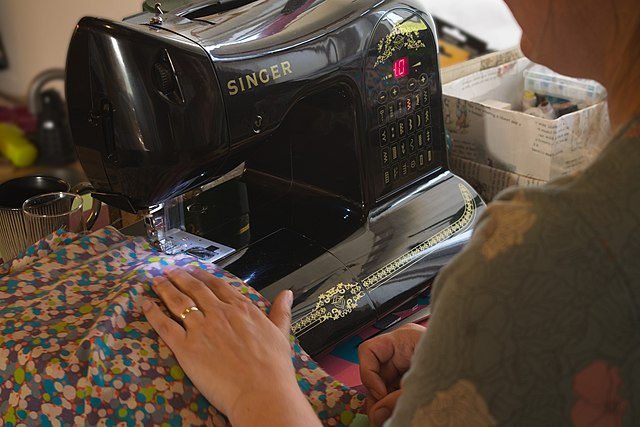 Vintage clothing is popular right now. There is a growing interest in slow fashion, in well-crafted clothing and in exploring styles that favor a person’s body type. Some people enjoy the fabrics and construction of older clothing. Other people want to reproduce a look made popular by celebrities or social media influencers. What is vintage? Vintage clothing is anything more than 50 years old. So pre-1972. Unfortunately, the fabric is not always in good shape in older clothing or it’s hard to find a look you like in your size. What to do? Sew your own!
Vintage clothing is popular right now. There is a growing interest in slow fashion, in well-crafted clothing and in exploring styles that favor a person’s body type. Some people enjoy the fabrics and construction of older clothing. Other people want to reproduce a look made popular by celebrities or social media influencers. What is vintage? Vintage clothing is anything more than 50 years old. So pre-1972. Unfortunately, the fabric is not always in good shape in older clothing or it’s hard to find a look you like in your size. What to do? Sew your own!
Back about a million years ago (1986) I fell in love with Barbara Michaels’ books. I own most of them even though they are so old they are falling apart. Anyway, one of those books is “Shattered Silk.” We follow along as Karen builds a vintage designer collection… and solves a mystery despite the dangerous, quirky characters lurking about her Georgetown home. The bits of research into designer fashion made this book especially enjoyable for me, plus dressing for your body type is part of the plot. Karen is “all tush” and looks great in the swing styles while her business partner is curvy and so successfully wears the ‘sweet sixteen’ dresses.
If you don’t have an eye for what will look good on you, we have several items that will help you develop that eye. “Your Body, Your Style” by Rani St. Pucchi helps you identify your body type and in a later chapter, what does and does not look good on your body. Personal taste aside, I know that frilly, flowery dresses do not look good on my apple-shaped body. I can just flip past those fashions while looking for the smaller prints, crisper fabrics and empire waistlines I feel best in.
“The Vintage Pattern Selector” has a great section on dresses and their silhouettes through the decades, plus excellent construction suggestions for the four dresses included on the enclosed CD. I’m one of the people drawn to historical dresses and enjoyed studying them. All in all, you have 15 patterns to print off if you wish, but I found the history woven into the book the most interesting. You can compare historic images of blouses, skirts, suits and more with contemporary versions of the same retro styles. Learn why women wore a style for what sort of activity and what fabrics and accessories were selected. If you are hunting in retail shops or estate sales, studying this book will help you learn to quickly identify quality vintage styles found on the racks.
“The Gentleman’s Wardrobe” is about sewing menswear and so its projects are things like a jacket and cravat tie. It’s more formal styling than casual with patterns and adaptions for bespoke garments such as trousers and jackets. This books features excellent tailoring techniques paired with illustrations. Pull-out patterns are included for small-medium-large sizing. (Oh, and by the way, if you do use one of these books for patterns, plan to purchase pattern tracing paper or some other method of copying the patterns rather than cutting into the library’s copy.)
You can find similar pull-out patterns in “BurdaStyle Sewing Vintage Modern” written by Nora Bousteit and Jamie Lau. It contains five basic patterns and then a number of variations of each. It guides you into the iconic looks of each decade between 1920s to 1980s and some of the basic patterns find their way into each decade. The Elizabeth Gathered-Waist is a great pattern for a Dior’s New Look dress. You also learn how to adapt it into a petticoat. You need a good petticoat to get your dress to flare properly.
I have mixed reviews for “ThriftStyle” which contains a lot of information about brands and updating thrifted clothing to runway styles. It includes finding high-fashion pieces, cleaning and preparing them for sale. In my opinion, it is not written for a vintage fashionista. I’m including it in this article as it is a useful book for anyone starting their thrifting journey, including how to recognize designers. Another bit of history I liked was where to date an American-made garment by union labels. Cornell University has this database on the subject and I wouldn’t have known about it except for a mention in ThriftStyle.
Turning to our digital library, you can find both informational articles in resources such as American History Online (where a search for fashion taught me that there was a 1720’s law prohibiting cotton and calicos in England), EBSCOhost eBook Collection (where I found a book by one of the CreativeBug instructors, a book we own), and any other encyclopedia or history database available to you.
“Gertie Sews Jiffy Dresses,” by the way, has good instructions on fine techniques for fitting and finishing your creations. Gretchen Hirsch will not give you bad advice about patterns, fabric, how-to-dos or anything else!
I love when people are wearing vintage clothing styles, especially when I recognize the decade the style was first popular! That doesn’t happen very often here at the Columbia Public Library, but maybe after reading this you will be inspired to sew or buy some vintage fashion and then come visit us!
Image credits: Sewing Dress, Roued via Flickr (license)



